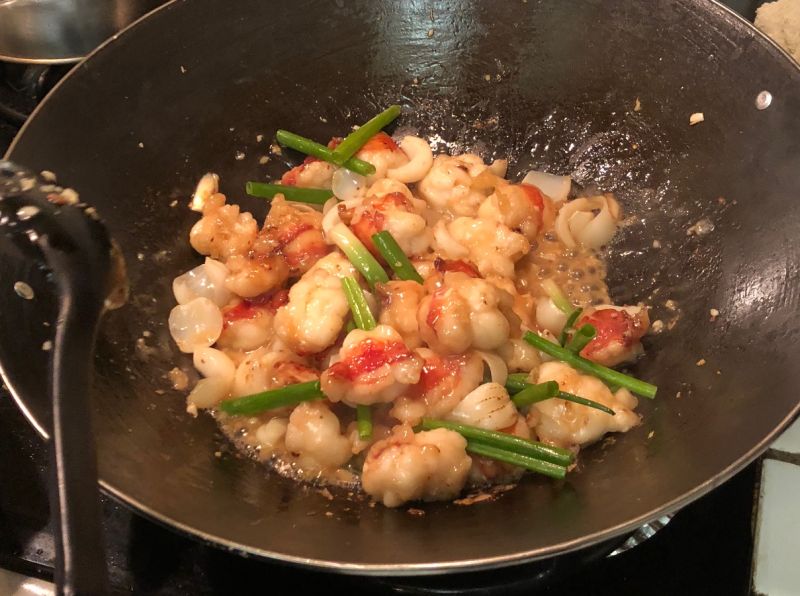
It had been many years since my family celebrated Tet together but for this year, Lunar New Year fell on Friday and the long President's Day weekend. My dad has been dealing with some health issues so my husband and I drove about 7 hours to spend the weekend with my parents. I also volunteered to make a special dinner on Friday, the first day of the Year of the Dog. My parents are Catholic and were observing Lent, too.
For that reason, the menu was decidedly seafood centric. With Valentine’s Day happening last week, too, I scored gorgeous lobster tails at Costco. The Seafood Roadshow guy told me that six of them would equal roughly 1 ½ pounds. I asked him to select big ones since they'll have more meat, plus the prep work remains the same. My aim was to make a Cantonese-style lobster stir-fry.
The thing is I wanted something different -- that was lobster-y and easy to eat. Fumbling with lobster shells just didn't seem like a good way to start the year. The stir-fry typically is made by cutting up a fresh lobster into shell-on pieces and then deep-frying the pieces before they're stir-fried with aromatics and sauce.
Tet called for a more elegant preparation. To that end, I removed the meat (the recipe has detailed instructions) from the tails and used the shells to make a lobster stock. Shrimp were also on the menu, so I threw the shells into the pressure cooker too. After about 30 minutes, I had a lovely, flavorful broth -- which I then froze for easy traveling. With flesh and stock prepped, it was easy to transport and put the dish together at my parents' home.
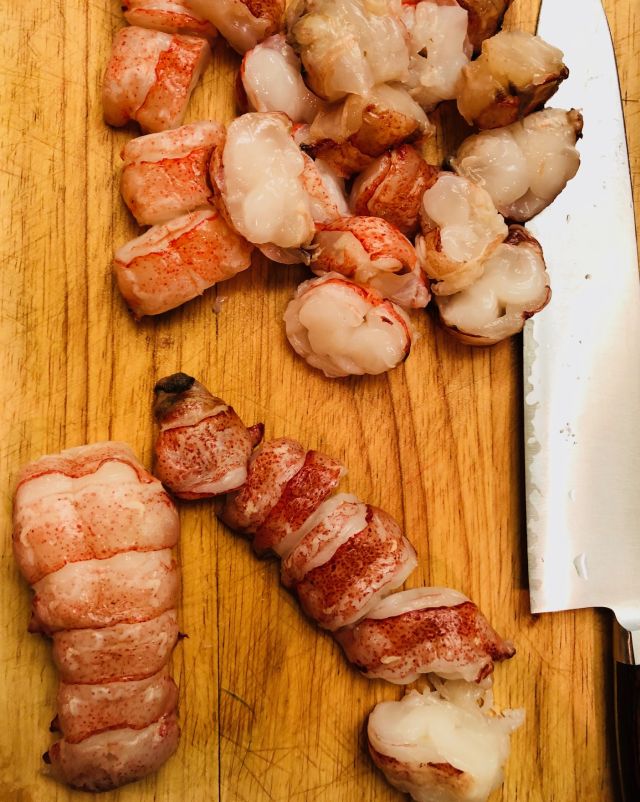
Because the lobster meat was to be cooked sans shells, I wanted extra texture. That's where fresh edible lily bulbs came in. I'd recently had it at a Shanghai restaurant, and during a last-minute stop at 99 Ranch market in Irvine, CA, I spied fresh lily bulbs from Japan. The ones from China are often sold in vacuum-sealed packaging. Have you ever had lily bulb? They're incredibly interesting.
The bulbs of Lilium brownii (Chinese lily) are like a cross between water chestnut and sweet potato. They are often included in stir-fries and soups. Lily bulbs are regularly available dried at Chinese markets, but the fresh kind is a special-event kind of ingredient; it's not easily found, and in All Under Heaven, Carolyn Phillips suggests substituting water chestnut or jicama for crunch.
Lily bulbs play a role in Chinese medicine. I felt a sense of calm after eating them. My parents, brother, niece, and husband delighted in trying something new and delicious. My Lunar New Year luck was in finding them fresh! Yes, edible lily bulbs sound obscure but if and when you run into them, give them a try!
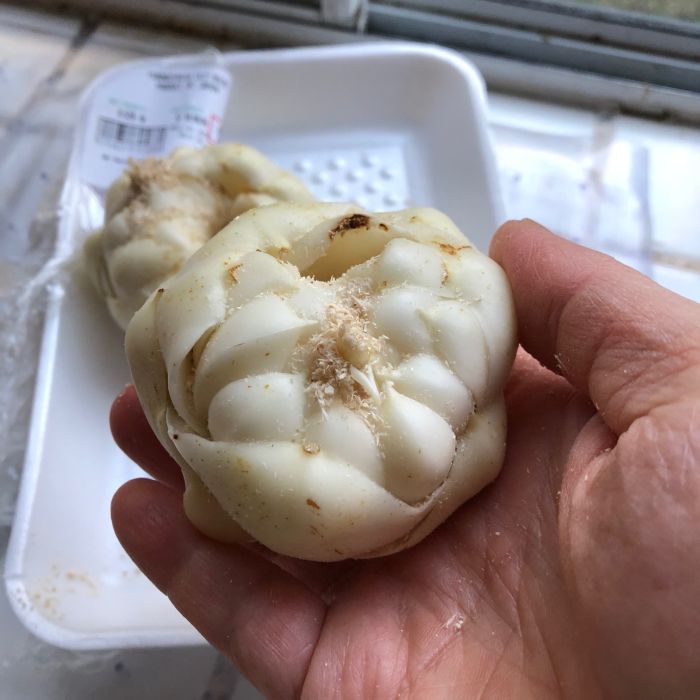
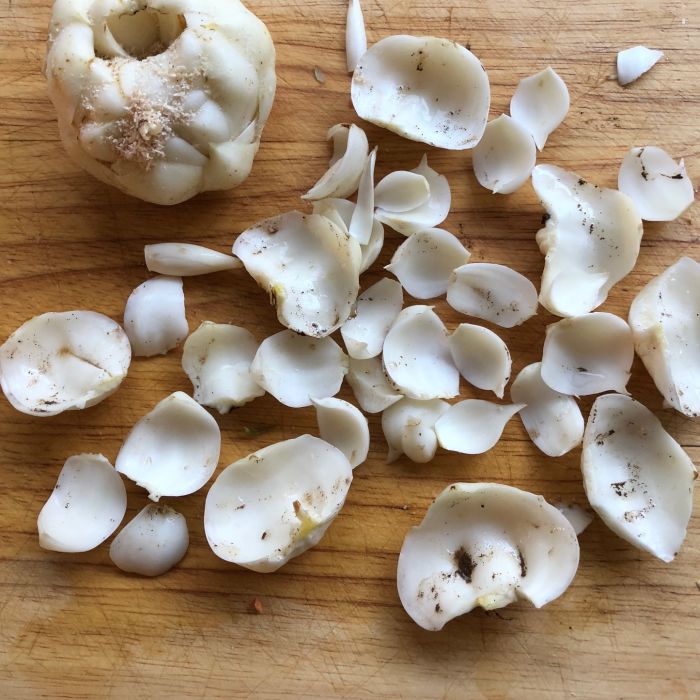
Lily bulbs look like unusual heads of peeled garlic but when you open them up, you realize that they are shaped as petal-shaped pieces. There's dirt stuck inside so a good washing is necessary. I use a paring knife to scrape away super dark spots but they were not a big deal. More on edible lily bulbs can be found at Red Cooking.
Closer in to cooking time, I cut the lobster tails into large chunks, then coated them with seasoned cornstarch, and quickly deep-fry them to create a crisp texture and seal in flavor. I've seen traditional Cantonese lobster recipes call for 3 cups of oil for deep-frying in a wok but I got away with about 1 ¼ cups since I didn't have shells to deal with.
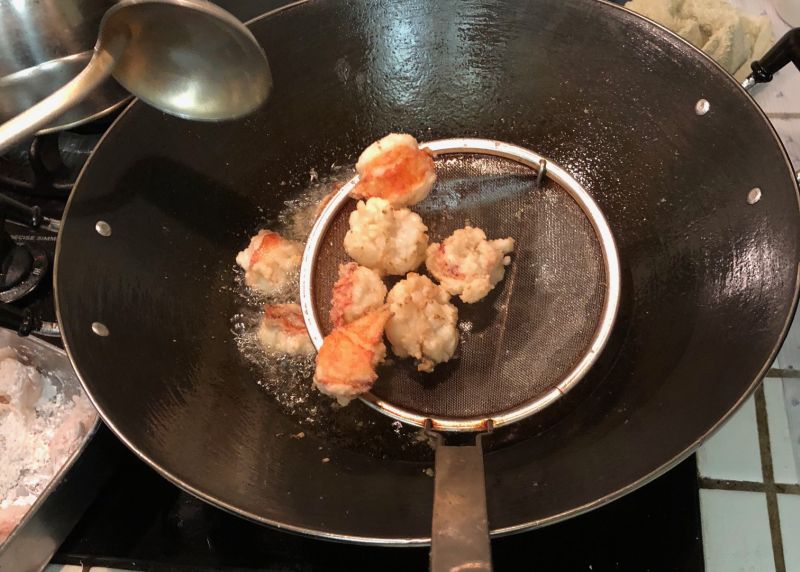
The fried lobster tails hung out for about 20 minutes while I finished the other three dishes on our menu (asparagus and king mushroom, crab and glass noodles, and a kohlrabi salad). You can likely let them sit longer, say 1 hour, or refrigerate it. The lobster does not stay crisp. That is its nature.
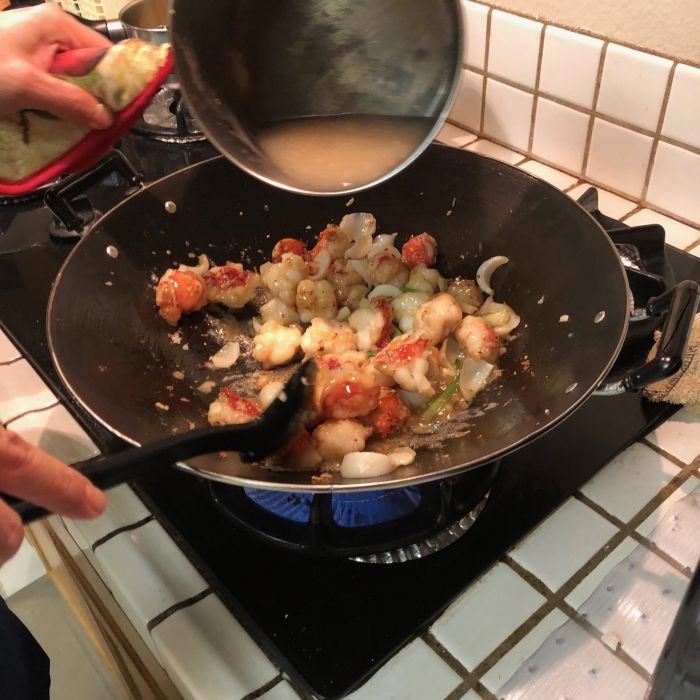
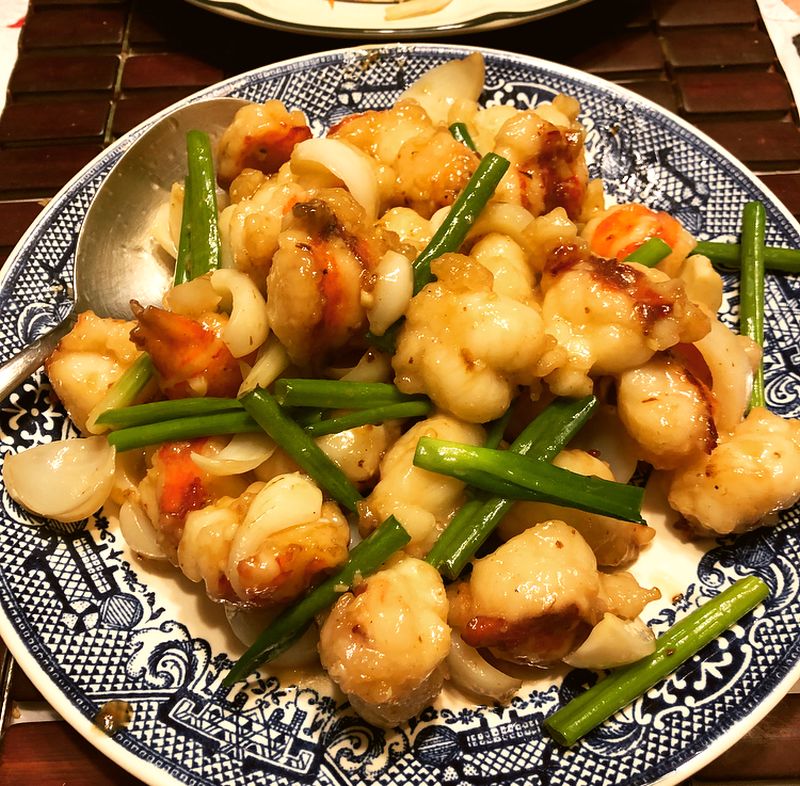
Right at the end, all the ingredients came together and the seasoned lobster stock was added. About minute later, the dish was done and served. My dad gave it a thumb's up Tet meal. My mom said it was better than going to a restaurant. It was a good Tet celebration.
Lobster Tail and Ginger Stir-Fry
Yield 4 to 6 servings
When lily bulb isn’t available, substitute ½ cup thinly sliced water chestnut or bite-size pieces of jicama. Add shrimp shells to the lobster shells for an even more flavorful broth.
Ingredients
- 6 uncooked lobster tails, 1 ½ to 1 ¾ pounds total
- 2 slices ginger, each ¼ inch thick and smashed
- ½ cup sliced yellow onion
- ⅓ cup chopped peeled Fuji apple, or ⅛ ounce Chinese yellow rock sugar
- Fine sea salt
- 1 (4-ounce) fresh lily bulb, trimmed, “petals” detached and well washed (see photos in main post)
- ⅛ teaspoon recently ground white pepper
- ⅓ cup plus 1 ½ teaspoons cornstarch
- 1 ½ teaspoons soy sauce
- 1 tablespoon Shaoxing rice wine
- About 1 ¼ cups neutral oil, such as canola (for shallow frying and stir-frying)
- 4 small or 2 medium green onions, cut into 2-inch sections, white and green parts kept separate
- Chubby 1 ½ inches fresh ginger, peeled and finely chopped or cut into fine matchsticks
Instructions
- Remove the meat from each lobster tail. Twist and pull off the round tail fins to free some of the flesh at the base. With curved side down, use poultry sheers to cut through the stiff white shell pieces and opaque white membrane (imagine breaking the rungs of a ladder). Starting from the base of the tail, apply gentle force to peel away the shell pieces. It often helps to crack or break the curved side of the shell (hold on to the shell from the back side and squeeze). Pull out the tail flesh and set aside on a plate or storage container. Refrigerate for up to 48 hours. Save the shell pieces!
- In a medium pot or 6-quart pressure cooker over medium heat, dry saute the ginger slices and sliced onion for 1 to 2 minutes, until fragrant. Add the lobster shell pieces and cook, until fragrant with lobster goodness. If using a regular pot, add water to cover by ¾ inch. If using a pressure cooker, add water to just cover. Add the apple (or sugar) plus ¼ teaspoon salt. Simmer for 45 minutes in a regular pot, or cook at high pressure for 15 minutes in a pressure cooker then release pressure naturally. Strain through a fine mesh strainer. Discard the solids. Use the stock or chill it till you need it for the stir-fry.
- In a shallow container or on a plate, combine ¼ teaspoon salt, the white pepper and ⅓ cup cornstarch. Set aside. Cut each the lobster tail crosswise into 5 pieces. Toss in the seasoned cornstarch mixture.
- Pour enough oil into a large wok to a depth of 1 inch; you’ll need about 1 ¼ cups. Heat over medium-high heat to roughly 375F. In 2 or 3 batches, fry the lobster pieces, gently dropping each into the hot oil. Fry for 45 to 60 seconds, until crisp. Use a ladle to agitate and coat the lobster with oil. It will not brown. The coating will look clear; don’t expect browning. Use a spider or slotted spoon to remove the lobster from the oil and deposit on paper towel to drain. The fried lobster can sit for about 20 minutes, partially covered, if needed to prevent drying.
- Let the oil cool for 5 minutes before carefully pouring it into a pot to finish cooling. Meanwhile, combine a generous ⅓ cup of the lobster stock with the soy sauce and rice wine. Taste to make sure there is a mild salty flavor. It will intensify during cooking.
- Reheat the wok over medium-high or high heat. Add the 2 tablespoons oil (if the oil used for frying the lobster was fresh, use it!). Add the white sections of green onion and ginger. Stir-fry for 45 to 60 seconds, until aromatic. Add the lily bulb, stir-fry for 1 to 2 minutes until heated through and barely tender; splash in 1 to 2 tablespoons lobster stock to facilitate cooking, as needed.
- Return the lobster to the pan. Stir-fry to heat through, 1 to 2 minutes. Give the seasoned stock a stir, then pour into the wok. Stir to combine. When things start bubbling soon, add the remaining green onion sections. Cook until barely or just wilted then remove from the heat. Transfer to a plate and serve immediately.
Courses Lunch, Dinner
Cuisine Chinese













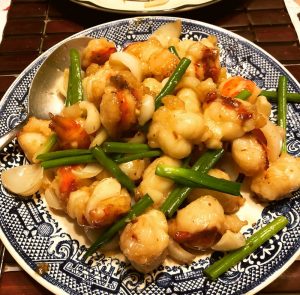




Thao says
Thank you Chi for sharing this recipe. I've never heard of or tried Lily bulbs but it sounds wonderful!
Andrea Nguyen says
I hadn't either. My parents, brother and husband found that the lily bud provided not just a new taste but also fun. It was perfect for Tet! We're suppose to have fun. Hope yours was a good one. Thanks for writing.